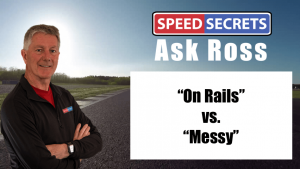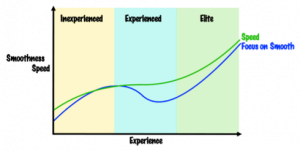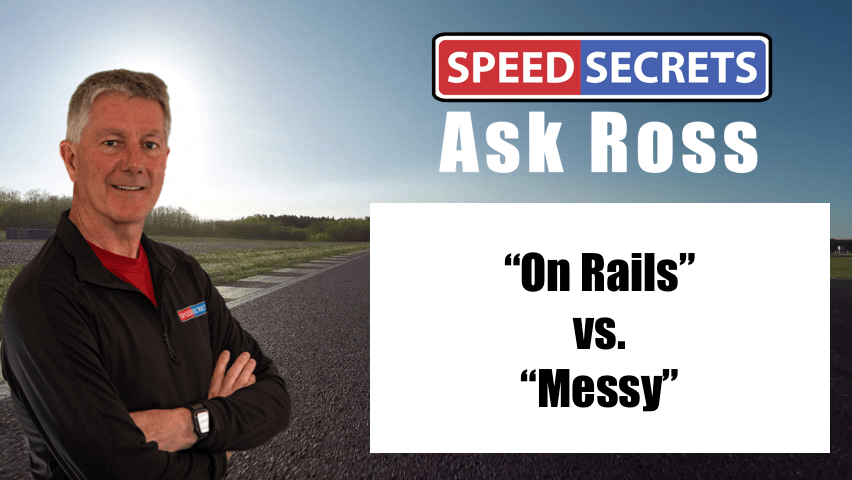 Q: “I just finished reviewing your Cornering Masterclass webinar. I like watching the recorded version so I can stop it and take notes. One thing popped up in my mind that I think you have already addressed indirectly but I would like some confirmation that I am thinking about this correctly. Over the years I have heard drivers say their car was like on rails their last session. Every time I felt that my car was on “Rails” it was a slow lap. Where I live we run Time Trials events at our local go-kart track. It is 0.9 of a mile and 11 corners and you are busy. I can’t seem to make smooth inputs/”car is on rails” translate into a fast lap. In fact, all my fastest laps are a little messy. After your webinar I feel like I need the car to be moving around a little to know I am pushing it some and getting some feedback from the car. Am I confusing two different things with the car on “Rails” and a messy lap? On bigger tracks I feel like I am smoother and maybe approaching the car on “Rails.” Thoughts, advice?”
Q: “I just finished reviewing your Cornering Masterclass webinar. I like watching the recorded version so I can stop it and take notes. One thing popped up in my mind that I think you have already addressed indirectly but I would like some confirmation that I am thinking about this correctly. Over the years I have heard drivers say their car was like on rails their last session. Every time I felt that my car was on “Rails” it was a slow lap. Where I live we run Time Trials events at our local go-kart track. It is 0.9 of a mile and 11 corners and you are busy. I can’t seem to make smooth inputs/”car is on rails” translate into a fast lap. In fact, all my fastest laps are a little messy. After your webinar I feel like I need the car to be moving around a little to know I am pushing it some and getting some feedback from the car. Am I confusing two different things with the car on “Rails” and a messy lap? On bigger tracks I feel like I am smoother and maybe approaching the car on “Rails.” Thoughts, advice?”
A: I think comments like “My car was on rails,” or “I held my breath and went for it,” are just things people say. To me, “on rails” means the driver was not fighting the car, like it was very well balanced. It doesn’t mean that the car wasn’t moving around, like you’re experiencing when you’re fast.
I also think there is a time to get a bit messy. One way of being smooth is to be slow! In fact, I often see drivers who are overly-focused on being smooth, and they miss out on knocking the few tenths (or more) off their lap times because of it.
 I’ve drawn a graph here that I use to illustrate this. In the beginning, when you’re just starting track driving, and for some time after that, it’s most important to work on developing your smoothness. That’s where drivers should start. With that smoothness will come a balanced car, which leads to more grip, which leads to more speed. In other words, smooth is fast – the focus is on improving speed by being smooth. Eventually, though, to get to the really fast stage that comes with more experience, a driver needs to get a bit messy – they need to throw the car around, building their car control skills. Yes, sometimes that leads to a spin, a half-spin, or an off. But in the process, the driver is learning the control skills that will take them to the next level. Sometimes, during this stage, lap times actually suffer a bit; sometimes they improve. The “final” (it’s actually never-ending) stage or level is where the driver begins to smooth out the messiness, fine-tuning their skills and techniques, giving the car ultimately what it wants and needs to be driven at the limit, and speed really improves.
I’ve drawn a graph here that I use to illustrate this. In the beginning, when you’re just starting track driving, and for some time after that, it’s most important to work on developing your smoothness. That’s where drivers should start. With that smoothness will come a balanced car, which leads to more grip, which leads to more speed. In other words, smooth is fast – the focus is on improving speed by being smooth. Eventually, though, to get to the really fast stage that comes with more experience, a driver needs to get a bit messy – they need to throw the car around, building their car control skills. Yes, sometimes that leads to a spin, a half-spin, or an off. But in the process, the driver is learning the control skills that will take them to the next level. Sometimes, during this stage, lap times actually suffer a bit; sometimes they improve. The “final” (it’s actually never-ending) stage or level is where the driver begins to smooth out the messiness, fine-tuning their skills and techniques, giving the car ultimately what it wants and needs to be driven at the limit, and speed really improves.
And yes, the tighter the track, usually the more you have to “throw the car around” (another thing that us drivers say, that isn’t entirely accurate – no one that I know of can actually pick a car up with one or two hands and throw it!). What you have to do is rotate the car to change directions more dramatically, since the corners are tighter radius. If you recall from the Cornering Masterclass, I said that in slow, tight radius corners you compromise overall grip a little to get the car to change direction; when you’re smooth, you cause less load transfer, meaning that you have more overall grip but it’s harder to rotate the car and change direction. On a long, fast track with large radius corners, it’s better to compromise changing direction as dramatically for more overall grip.
In the end, I think you’re on the right track (no pun intended) in terms of balancing “on rails” with being “messy.”

